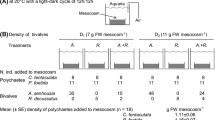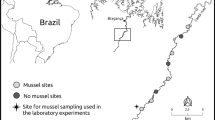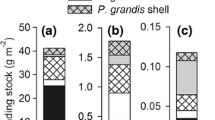Abstract
Nutrient recycling by consumers can strongly impact nutrient availability for autotrophic and heterotrophic microbes, thus impacting functions such as primary production and decomposition. Filter-feeding freshwater mussels form dense, multispecies assemblages in aquatic ecosystems and have been shown to play a critical role in nutrient cycling. Mussel excretion can enhance benthic primary production and influence algal species composition. However, the role of mussels in brown or detritus-based food webs and species-specific differences has received considerably less attention. Here, using mesocosm experiments, we assessed how three species of freshwater mussels that occupy three different phylogenetic tribes influenced benthic algal accrual, ecosystem metabolism, cotton strip decomposition, leaf litter (Acer saccharum) decomposition, and litter-associated fungal biomass measured as ergosterol. Additionally, we measured mussel excretion and biodeposition rates and assessed the stoichiometry (C:N, C:P, and N:P) of the benthic algae, cotton strips, and leaf litter. In comparison to controls without mussels, generally, mussel treatments had higher benthic algal biomass composed of more diatoms, higher gross primary productivity and net ecosystem production rates, and higher cotton strip tensile strength loss, but there was not a difference in ecosystem respiration rates, leaf litter decomposition rates, or fungal biomass. Benthic algae had lower C:N and higher N:P in mussel treatment tanks and cotton strip C:N was lower in mesocosms with mussels. Our results suggest that nutrient regeneration by mussels most strongly regulates green food webs, with some impacts to brown food webs, suggesting that consumers have interactive effects on microbial functioning in freshwaters.





Similar content being viewed by others
References
Allen DC, Vaughn CC, Kelly JF, Cooper JT, Engel M (2012) Bottom-up biodiversity effects increase resource subsidy flux between ecosystems. Ecology 93:2165–2174
Allgeier JE, Yeager LA, Layman CA (2013) Consumers regulate nutrient limitation regimes and primary production in seagrass ecosystems. Ecology 94:521–529
Atkinson CL, Vaughn CC (2015) Biogeochemical hotspots: temporal and spatial scaling of the impact of freshwater mussels on ecosystem function. Freshw Biol 60:563–574
Atkinson CL, Vaughn CC, Forshay KJ, Cooper JT (2013) Aggregated filter-feeding consumers alter nutrient limitation: consequences for ecosystem and community dynamics. Ecology 94:1359–1369
Atkinson CL, Kelly JF, Vaughn CC (2014) Tracing consumer-derived nitrogen in riverine food webs. Ecosystems 17:485–496
Atkinson CL, Capps KA, Rugenski AT, Vanni MJ (2017) Consumer-driven nutrient dynamics in freshwater ecosystems: from individuals to ecosystems. Biol Rev 92:2003–2023
Atkinson CL, Sansom BJ, Vaughn CC, Forshay KJ (2018) Consumer aggregations drive nutrient dynamics and ecosystem metabolism in nutrient-limited systems. Ecosystems 21:521–535
Atkinson CL, van Ee BC, Pfeiffer J (2020b) Evolutionary history drives aspects of stoichiometric niche variation and functional effects within a guild. Ecology 101:e03100
Atkinson CL et al (2020a) Length-mass equations for freshwater unionid mussel assemblages: implications for estimating ecosystem function. Freshw Sci 39:377–390
Barlocher F (2005) Freshwater fungal communities. Mycol Ser 23:39
Buchkowski RW, Leroux SJ, Schmitz OJ (2019) Microbial and animal nutrient limitation change the distribution of nitrogen within coupled green and brown food chains. Ecology 100:e02674
Cheever BM, Webster JR (2014) Effects of consumers and nitrogen availability on heterotrophic microbial activity during leaf decomposition in headwater streams. Freshw Biol 59:1768–1780
Cheever BM, Webster JR, Bilger EE, Thomas SA (2013) The relative importance of exogenous and substrate-derived nitrogen for microbial growth during leaf decomposition. Ecology 94:1614–1625
Covich AP, Palmer MA, Crowl TA (1999) The role of benthic invertebrate species in freshwater ecosystems—zoobenthic species influence energy flows and nutrient cycling. Bioscience 49:119–127
Cross WF, Wallace JB, Rosemond AD, Eggert SL (2006) Whole-system nutrient enrichment increases secondary production in a detritus-based ecosystem. Ecology 87:1556–1565
Doughty CE et al (2016) Global nutrient transport in a world of giants. Proc Natl Acad Sci 113:868–873
Evans-White MA, Halvorson HM (2017) Comparing the ecological stoichiometry in green and brown food webs—a review and meta-analysis of freshwater food webs. Front Microbiol 8:1184
Findlay SE, Dye S, Kuehn KA (2002) Microbial growth and nitrogen retention in litter of Phragmites australis compared to Typha angustifolia. Wetlands 22:616–625
Gulis V, Suberkropp K (2003b) Leaf litter decomposition and microbial activity in nutrient-enriched and unaltered reaches of a headwater stream. Freshw Biol 48:123–134
Gulis V, Suberkropp K (2003a) Interactions between stream fungi and bacteria associated with decomposing leaf litter at different levels of nutrient availability. Aquat Microb Ecol 30:149–157
Haag WR, Warren ML (2010) Diversity, abundance, and size structure of bivalve assemblages in the Sipsey River, Alabama. Aquat Conserv Mar Freshw Ecosyst 20:655–667
Hall RO, Tank JL, Dybdahl MF (2003) Exotic snails dominate nitrogen and carbon cycling in a highly productive stream. Front Ecol Environ 1:407–411
Halvorson HM, Atkinson CL (2019) Egestion versus excretion: a meta-analysis examining nutrient release rates and ratios across freshwater fauna. Diversity 11:189
Halvorson HM, Scott EE, Entrekin SA, Evans-White MA, Scott JT (2016) Light and dissolved phosphorus interactively affect microbial metabolism, stoichiometry and decomposition of leaf litter. Freshw Biol 61:1006–1019
Halvorson HM, Hall DJ, Evans-White MA (2017) Long-term stoichiometry and fates highlight animal egestion as nutrient repackaging, not recycling, in aquatic ecosystems. Funct Ecol 31:1802–1812
Halvorson HM, Barry JR, Lodato MB, Findlay RH, Francoeur SN, Kuehn KA (2019) Periphytic algae decouple fungal activity from leaf litter decomposition via negative priming. Funct Ecol 33:188–201
Harpole WS et al (2011) Nutrient co-limitation of primary producer communities. Ecol Lett 14:852–862
Howard JK, Cuffey KM (2006) The functional role of native freshwater mussels in the fluvial benthic environment. Freshw Biol 51:460–474
Jabiol J, Cornut J, Tlili A, Gessner MO (2018) Interactive effects of dissolved nitrogen, phosphorus and litter chemistry on stream fungal decomposers. FEMS Microbiol Ecol 94:fly151
Kuehn KA, Francoeur SN, Findlay RH, Neely RK (2014) Priming in the microbial landscape: periphytic algal stimulation of litter-associated microbial decomposers. Ecology 95:749–762
Loreau M, Hector A (2001) Partitioning selection and complementarity in biodiversity experiments. Nature 412:72–76
Manning DW, Rosemond AD, Gulis V, Benstead JP, Kominoski JS, Maerz JC (2016) Convergence of detrital stoichiometry predicts thresholds of nutrient-stimulated breakdown in streams. Ecol Appl 26:1745–1757
Manzoni S, Trofymow JA, Jackson RB, Porporato A (2010) Stoichiometric controls on carbon, nitrogen, and phosphorus dynamics in decomposing litter. Ecol Monogr 80:89–106
McIntyre PB, Flecker AS, Vanni MJ, Hood JM, Taylor BW, Thomas SA (2008) Fish distributions and nutrient cycling in streams: can fish create biogeochemical hotspots? Ecology 89:2335–2346
McNaughton S, Ruess R, Seagle S (1988) Large mammals and process dynamics in African ecosystems. Bioscience 38:794–800
McNaughton S, Banyikwa F, McNaughton M (1997) Promotion of the cycling of diet-enhancing nutrients by African grazers. Science 278:1798–1800
Moore JC et al (2004) Detritus, trophic dynamics and biodiversity. Ecol Lett 7:584–600
Nickerson ZL, Green PAM, Shouse LN, Atkinson CL (accepted) Enhanced species richness of functionally similar stream consumers results in higher ecological function. Freshw Sci
Parr TB, Capps KA, Inamdar SP, Metcalf KA (2019) Animal-mediated organic matter transformation: aquatic insects as a source of microbially bioavailable organic nutrients and energy. Funct Ecol 33:524–535
Paul MJ, Meyer JL, Couch CA (2006) Leaf breakdown in streams differing in catchment land use. Freshw Biol 51:1684–1695
Ramamonjisoa N, Natuhara Y (2018) Contrasting effects of functionally distinct tadpole species on nutrient cycling and litter breakdown in a tropical rainforest stream. Freshw Biol 63:202–213
Roman J, McCarthy JJ (2010) The whale pump: marine mammals enhance primary productivity in a coastal basin. PLoS ONE 5:e13255
Romaní AM, Fischer H, Mille-Lindblom C, Tranvik LJ (2006) Interactions of bacteria and fungi on decomposing litter: differential extracellular enzyme activities. Ecology 87:2559–2569
Rosemond AD et al (2015) Experimental nutrient additions accelerate terrestrial carbon loss from stream ecosystems. Science 347:1142–1145
Rugenski AT, Murria C, Whiles MR (2012) Tadpoles enhance microbial activity and leaf decomposition in a neotropical headwater stream. Freshw Biol 57:1904–1913
Sitters J, Bakker ES, Veldhuis MP, Veen GF, Olde Venterink H, Vanni MJ (2017) The stoichiometry of nutrient release by terrestrial herbivores and its ecosystem consequences. Front Earth Sci 5:32
Solorzano L, Sharp JH (1980) Determination of total dissolved phosphorus and particulate phosphorus in natural waters. Limnol Oceanogr 25:754–757
Spooner DE, Vaughn CC (2006) Context-dependent effects of freshwater mussels on stream benthic communities. Freshw Biol 51:1016–1024
Spooner DE, Vaughn CC, Galbraith HS (2012) Species traits and environmental conditions govern the relationship between biodiversity effects across trophic levels. Oecologia 168:533–548
Spooner DE, Frost PC, Hillebrand H, Arts MT, O. P, Xenopoulos MA, (2013) Nutrient loading associated with agriculture land use dampens the importance of consumer-mediated niche construction. Ecol Lett 16:1115–1125
Suberkropp K, Gulis V, Rosemond AD, Benstead JP (2010) Ecosystem and physiological scales of microbial responses to nutrients in a detritus-based stream: results of a 5-year continuous enrichment. Limnol Oceanogr 55:149–160
Tank JL, Dodds WK (2003) Nutrient limitation of epilithic and epixylic biofilms in ten North American streams. Freshw Biol 48:1031–1049
Tiegs SD, Clapcott JE, Griffiths NA, Boulton AJ (2013) A standardized cotton-strip assay for measuring organic-matter decomposition in streams. Ecol Ind 32:131–139
Turner JT (2015) Zooplankton fecal pellets, marine snow, phytodetritus and the ocean’s biological pump. Prog Oceanogr 130:205–248
van der Waal C et al (2011) Large herbivores may alter vegetation structure of semi-arid savannas through soil nutrient mediation. Oecologia 165:1095–1107
Vaughn CC, Hakenkamp CC (2001) The functional role of burrowing bivalves in freshwater ecosystems. Freshw Biol 46:1431–1446
Vaughn CC, Hoellein TJ (2018) Bivalve impacts in freshwater and marine ecosystems. Annu Rev Ecol Evol Syst 49:183–208
Vaughn CC, Spooner DE (2006) Unionid mussels influence macroinvertebrate assemblage structure in streams. J N Am Benthol Soc 25:691–700
Vaughn CC, Spooner DE, Galbraith HS (2007) Context-dependent species identity effects within a functional group of filter-feeding bivalves. Ecology 88:1654–1662
Webster J, Benfield E (1986) Vascular plant breakdown in freshwater ecosystems. Annu Rev Ecol Syst 17:567–594
Williams JD, Bogan AE, Garner JT (2008) Freshwater mussels of Alabama and the mobile basin in Georgia, Mississippi, and Tennessee. University of Alabama Press, Tuscaloosa
Wolkovich EM, Allesina S, Cottingham KL, Moore JC, Sandin SA, de Mazancourt C (2014) Linking the green and brown worlds: the prevalence and effect of multichannel feeding in food webs. Ecology 95:3376–3386
Wotton RS, Malmqvist B (2001) Feces in aquatic ecosystems. Bioscience 51:537–544
Zou K, Thébault E, Lacroix G, Barot S (2016) Interactions between the green and brown food web determine ecosystem functioning. Funct Ecol 30:1454–1465
Acknowledgements
This work would not have been possible without assistance from Brian van Ee, Lucas Edgren, Maya Owens-Freeman, Stephanie Koury, Tori Hebert and Jane Kundberger. We appreciate comments and advice on previous versions of this manuscript from Garrett Hopper, Arial Shogren and Irene Sanchez Gonzalez. The Alabama Department of Natural Resources and Conservation and the National Science Foundation DEB-1831512 provided support for this project. Freshwater mussel collection was conducted under ALCDNR Permit # 2016077745468680.
Author information
Authors and Affiliations
Contributions
CLA and MNW conceived and designed the experiments. CLA, MW, and AH performed the experiments. MW conducted the chlorophyll-a analysis. CLA conducted the algae stoichiometry analysis. HMH and KAK conducted the ergosterol and leaf litter stoichiometry analysis. MNW conducted HPLC analysis. CLA performed the statistical analysis. CLA and HMH wrote the manuscript with all other authors providing editorial advice.
Corresponding author
Additional information
Communicated by Maarten Boersma.
Supplementary Information
Rights and permissions
About this article
Cite this article
Atkinson, C.L., Halvorson, H.M., Kuehn, K.A. et al. Filter-feeders have differential bottom-up impacts on green and brown food webs. Oecologia 195, 187–198 (2021). https://doi.org/10.1007/s00442-020-04821-7
Received:
Accepted:
Published:
Issue Date:
DOI: https://doi.org/10.1007/s00442-020-04821-7




